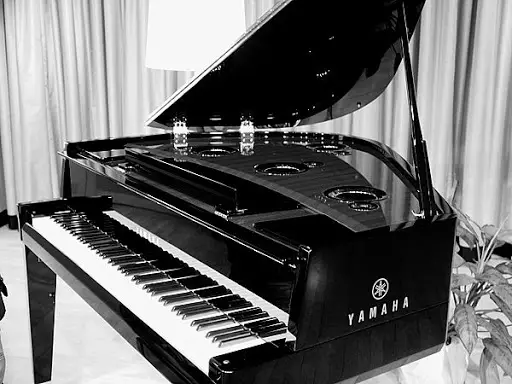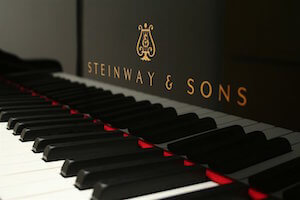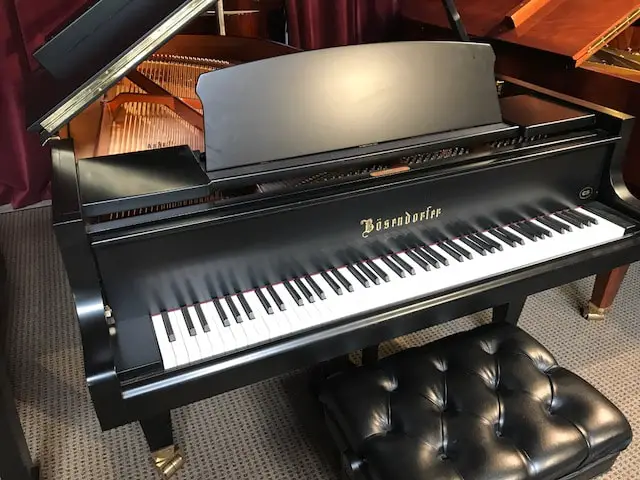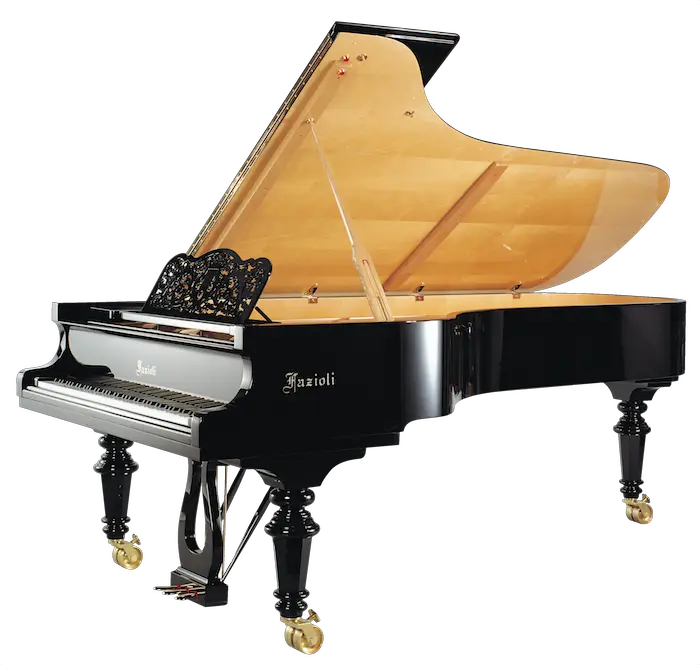There are all kinds of baby grand pianos on the market.
However, not all of them are made equal.
It can be hard to choose which one is best for you, especially since many look similar to the naked eye.
In this article, I’ll go over all the types of baby grand pianos, including things to keep in mind before buying one.
Table of Contents
- Types of Baby Grand Pianos on The Market
- Yamaha
- Steinway & Sons
- Bosendorfer
- Fazioli
- What To Look For When Buying a Baby Grand Piano
- Factors That Affect The Price of Baby Grand Pianos
- Baby Grand Piano – What You Need to Know? by Merriam Pianos
Types of Baby Grand Pianos on The Market
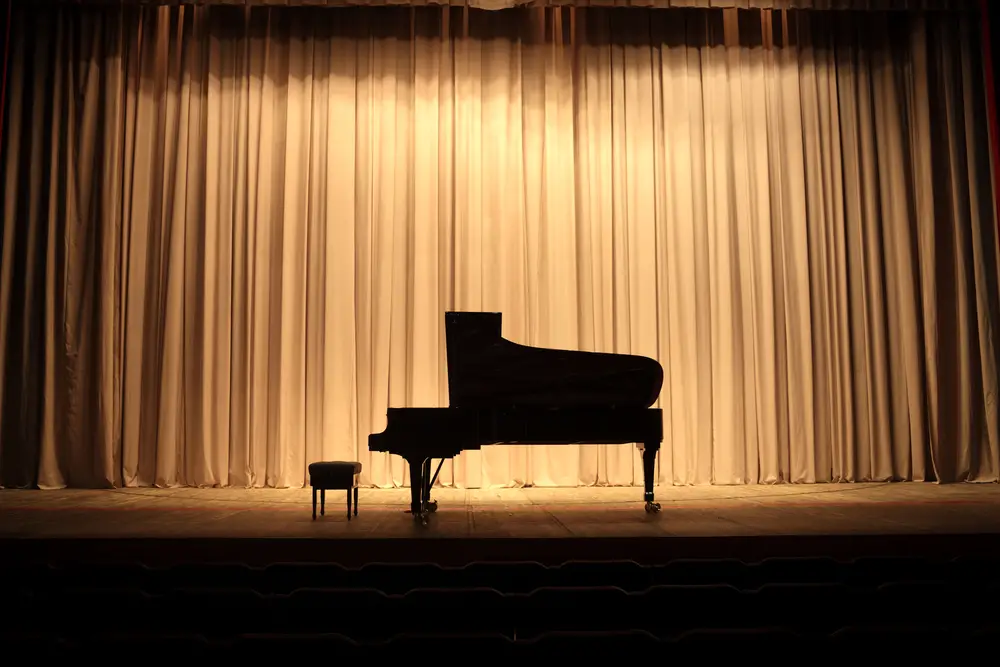
Since the grand piano’s invention in 1700, companies have competed to come up with the best model. Some were successful with their efforts, while others fell off the grid. Here are some of the most prominent companies on the market today:
- Yamaha
- Steinway & Sons
- Bosendorfer
- Fazioli
Yamaha
Yamaha is known for their high-quality, rich, and crisp-sounding baby grand pianos. Though Yamaha and Steinway build their pianos similarly, there are still some differences. For wood, Yamaha primarily uses spruce, oak, and mahogany, which they get from East Asia. This location is practical since the company’s headquarters are in Japan. The price of basic Yamaha baby grands is usually $5,000 to $30,000.
Inside the cabinet, Yamaha uses spruce, which is the most resonant type of wood. Full-length ribs line the whole soundboard. When looking inside the cabinet, you’ll find copper bass strings, quality hammers, and wooden bridges. Also, these pianos do very well in humidity changes, which is great. The reason for this lies in the aluminum alloy action rails. Humidity changes can be a silent but deadly killer for grand pianos and significantly detune them.
To create a highly-resonant sound, Yamaha uses their Duplex Scaling system in all baby grand pianos. “What’s that?” you may wonder. The Duplex Scaling system allows the strings to resonate even when they aren’t being used. Basically, it helps the piano produce a fuller and richer sound. Yamaha pianos tend to have a thick and high-quality frame, which is essential. If you don’t already know, the average baby grand piano has a total string tension of 36,000 pounds. That’s a lot. Now you can understand why a strong frame is necessary.
If you’ve ever played a Yamaha grand piano, you’ve likely experienced the bright and rich signature tone. Each of their pianos has a unique tone and character, which is cool. They’re known for producing crisp, clear tones, which are excellent for a wide variety of genres. Genres like Pop, Rock, Jazz, and Musicals call for the kind of brightness that Yamaha pianos have to offer. Another thing that these pianos excel in is consistency.
For example, all Yamaha GC1 baby grands will sound nearly identical regardless of the make. This uniformity is due to the company’s use of modern piano-building technology. Though they build lots of pieces by hand, machines also help to expedite the process.
In terms of touch, Yamaha pianos usually have excellent precision and accuracy. Skilled pianists have no problem played technically demanding songs.
Pros and Cons of Yamaha Baby Grands
PROS
- Duplex Scaling system
- Bright tone excellent for many genres
- High quality spruce soundboards
- Not as susceptible to humidity as other pianos
- Aluminum alloy action rails
CONS
- Can sound tinny or thin in the upper registers
Steinway & Sons
Steinway and Yamaha pianos have many similarities. One of them is a high-quality sound. However, Steinway baby grands tend to have a more rounded and mature tone. You can use Steinways for nearly every genre. They generally have a huge dynamic range, which is fantastic. For playing music with lots of character and emotion, these pianos are hard to beat. In general, they usually have a slightly richer sound than Yamahas. Steinway baby grands generally go for $20,000 to $60,000.
One slight downside of Steinway pianos is the inconsistency from piano to piano. Two pianos of the same model but different makes might sound slightly different from one another. On the other hand, this isn’t all bad. The slight inconsistency happens because of the company hand-crafting each piano. With technological advances in piano building, their hand-made pianos set them apart from many brands. Though there are some inconsistencies, it comes down to finding your favorite sound.
Pros and Cons of Steinway & Sons Baby Grands
PROS
- Massive dynamic range
- Richer tone than Yamahas
- Hand-crafted
CONS
- Slightly inconsistent
- Action isn’t as quick as Yamaha’s
Bosendorfer
Bosendorfer pianos come with a unique background. Ignaz Bosendorfer founded his piano company in 1828. Franz Liszt, one of the most virtuosic pianists of all time, endorsed Bosendorfer immediately. At the time, Liszt had a reputation for destroying pianos with his animated playing style. When he tried the Bosendorfer, he couldn’t break it no matter how hard he played. Since then, for nearly 200 years, Bosendorfer has remained one of the world’s most popular piano brands.
Something that sets their pianos apart is the unique rim design. In terms of sound, these pianos generally have a darker and richer tone than Yamahas and Steinways. Though the tone isn’t quite as pure as the Yamaha sound, many pianists, especially classical players, highly prefer it.
However, the price might set you back a bit. Inch for inch, Bosendorfers build some of the most expensive pianos. You can find baby grands for $30,000 to $100,000. But, there’s a reason for this elevated price. Their signature tone and sleek appearance make them some of the world’s most sought-after pianos.
Pros and Cons of Bosendorfer Baby Grands
PROS
- Rich, dark tone
- Unique rim design
- Sleep appearance
- Some have extra keys
- Most expensive brand
CONS
- Most expensive brand
Fazioli
Fazioli is the least known brand on the list. The company is less popular merely because of its short history. They build and produce their baby grand pianos in Italy. In general, Fazioli makes way fewer pianos per year than Steinway or Yamaha. Since their pianos take 2 to 3 years to make, they can only produce 140 per year. Because of the intense care put into each piano, their baby grands are around $100,000. Now that’s pricey. For most people, that’s way too expensive.
In terms of build quality, Fazioli pianos are superb. The soundboards are made with Italian red spruce. The company also outlines each piano with inner and outer rims made from maple. Pianists tend to love Faziolis for their ultra-rich tone and feathery touch. These pianos are masterfully crafted and perfectly balanced.
Throughout all registers, they have excellent regulation. With their responsive action, pianists can play the most virtuosic pieces without a problem. Similar to Yamaha’s pianos, Faziolis have a distinctive bright tone. They are in between Yamahas and Steinways in terms of brightness. However, the tone doesn’t take away from the powerful bass register.
Pros and Cons of Fazioli Baby Grands
PROS
- Powerful bass
- Near perfect regulation
- Option for a 4th pedal
- Feathery action
CONS
- Extremely expensive
- Not quite as rich as a Steinway’s tone
- Only 140 made per year
What To Look For When Buying a Baby Grand Piano
Since not all grand pianos are equal, there are some things to look for when buying one.
Rim
Walking into a piano store, one of the first things to look at is the piano’s rim. The rim outlines the bottom of the body and is a highly essential piece. It’s the main structural support of the piano. As pianos get more expensive, the rims become thicker and more high-quality. However, you may be able to find a cheaper baby grand piano that has an excellent rim. For those on a tight budget, this may be a good goal.
Action
Something else to look at is the action of the piano. Everyone has different preferences. You might enjoy a lighter key or a firmer one. Regardless, baby grand pianos have a wide range of actions. It all comes down to finding the feel that you love. Piano action also has another aspect, which is rebound speed. If you plan to play hard pieces, you’ll probably need very responsive action. You can test this by preparing a short, technically-demanding passage on several different pianos. If the keys seem a bit sluggish, that’s a big indicator.
Tone
It’s always a good idea to find your preferred tone in a piano. Some tones better suit different genres, so it’s important to figure out what you like. If you primarily play classical music, you may enjoy a darker sound. Many pieces, especially from the Romantic era, require lots of drama and emotion. A dark and rich tone often suits that the best. If you aren’t a classical pianist, however, things might be different. Lots of modern genres call for a bright and more percussive sound. Yamaha pianos often have the brighter sound that contemporary pianists enjoy.
Scratches and Damages
You might come across your seemingly perfect piano. The sound is great, the rim is high-quality, and it’s affordable. Before taking it as your own, it’s best to look for any scratches or past damages. You might even benefit from asking the seller about its past condition. Though it’s not a deal-breaker if it’s been damaged, it’s something to consider. Signs of wear and tear can sometimes make a piano more prone to future damages.
Factors That Affect The Price of Baby Grand Pianos
Why are some pianos $5,000, and why are others $80,000? Many people might wonder about this question when browsing baby grands.
The Rim
As I discussed, the rim is a crucial aspect to evaluate with pianos. Coincidentally, it also plays a huge role in the price. The rim quality can make or break a piano. Let’s say you find a 6-foot baby grand for $5,000. You also find a 5-footer for $7,000. The decision seems simple. The 6-foot piano is bigger and more affordable, so it’s the better deal out of the two. Or is it? Now, let’s say that the 5-footer has a much thicker rim. This changes things. That smaller piano might actually be the better deal in the long run. A thick rim will keep the piano together better.
Soundboard
The soundboard is another thing that significantly affects the price—specifically, the type and quality of wood. When you hear a piano, the sound you hear comes from the soundboard. By themselves, the strings are very quiet and comparable to a guitar’s volume. The soundboard is basically the baby grand’s natural speaker. For this reason, the type of wood that’s used is significant. Many pianos use spruce soundboards, which is a good thing. You can get a rich tone with spruce because it’s the most reverberant type of wood. Though Sitka spruce does an excellent job, there are still better soundboards out there. Some woods are thinner, more consistent, and even laminated.
A common discussion in the piano world is this: Which type of soundboard is better, a laminated or solid one? Though the topic is hyped up, there isn’t a significant difference between the two types. In the past, laminated soundboards were built very poorly, which gave them a bad reputation. Nowadays, piano manufacturers treat laminated soundboards with much more care. Companies that produce laminated boards will say they’re the best type. Solid board companies also make this claim about their technique.
So, it can be hard to figure it out. Solid boards are stiffer than laminated boards. However, this difference doesn’t guarantee anything with overall performance.
Size
One last thing that affects the price is size. Most baby grand pianos are between 4’6″ and 6′ long. In general, the smaller the piano, the lower the price. If you’re on a tight budget and still want a beautiful grand piano, you can find plenty under 5 feet long.


